My List
18 favourites found.Aristotelia serrata (Makomako, Wineberry)

Aristotelia serrata, commonly called Makomako or Wineberry, is a fast-growing, small deciduous tree. Attractive rose-coloured flowers in spring. Black berries in summer are highly sought after by native birds. Good shade tree in sheltered areas. Frost-tender when young, however hardy once mature.
Delicate, rose coloured flowers in early spring result in dark red berries in summer which are great for attracting birds. It has serrated, green leaves which may develop a purple hue, and typically grows to 5 m tall and 4 m wide. Wineberry is commonly used as a smaller specimen tree, trimmed into a hedge, or used for screening and shelter.
Best results with this tree are achieved when it is planted in full sun on a well-drained site. It will tolerate cool climates and moderate frost once established, as well as most soil conditions but only short periods of dry.
Habitat: Lowland to montane forests. Often forming dense thickets following disturbance.
Flowering: Spring [September - December]
Fruiting: Summer [January - March]
My Lists: Low Flammability Plants, Rongoa
Coprosma crassifolia (Mingimingi)

Coprosma crassifolia, commonly called mingimingi, is a stiffly-branched upright shrub with small dark-green leaves and white to pale-yellow berries that attract skinks and birds. It's a tough shelter and revegetation shrub for drought-prone sites. The upright, columnar habit is good for narrow spaces.
In the forest, the shrub is sparsely branched but in the open, it forms densely branched thickets. The stiff, more or less round remote leaves and the stiff, red-brown branchlets distinguish C. crassifolia from all other Coprosma species. The flowers are unisexual. The berries flesh is transparent but look white due to the white seed within. They may also look pale yellow.
Habitat: Coastal rocky and sandy lowland to lower montane shrubland and forest, up to 600 m.
Flowering: Spring [September - October]
Fruiting: Summer - Autumn [November - June]
My Lists: Low Flammability Plants
Coprosma propinqua (Mingimingi)

Coprosma propinqua, commonly known as Mingimingi, is a species of evergreen shrub or small tree that is native to New Zealand. It belongs to the family Rubiaceae and is known for its distinctive foliage and attractive appearance.
Coprosma propinqua exhibits a compact and bushy growth habit, typically reaching a height of 1 to 3 meters. The leaves are opposite, simple, and small, measuring about 1 to 3 centimeters in length. The leaves are elliptical or lanceolate in shape, with smooth margins, and are usually glossy and dark green in color. Some varieties may have variegated leaves with contrasting colors, such as yellow or cream markings.
The flowers of Coprosma propinqua are small and inconspicuous, typically greenish or yellowish in color. They are borne in clusters and are not particularly showy. The plant is dioecious, which means that male and female flowers are borne on separate plants.
The fruit of Coprosma propinqua is a fleshy drupe, typically spherical or ovoid in shape, and about 5 to 7 millimeters in diameter. The fruit initially appears green, but matures to a dark purple or black color when ripe. The fruit is often eaten by birds, which help to disperse the seeds.
Coprosma propinqua is commonly found in various habitats in New Zealand, including forests, shrublands, and coastal areas. It is known for its ability to tolerate a wide range of growing conditions, including poor soils and exposure to salt spray, making it a hardy and adaptable plant. It is also known to have medicinal properties and has been used traditionally by Maori for various purposes.
In cultivation, Coprosma propinqua is often used as an ornamental plant in gardens and landscapes due to its attractive foliage and low maintenance requirements. It can be grown as a standalone specimen plant, or used as a hedge or ground cover. It is typically propagated by seeds or cuttings, and prefers well-drained soils and a sunny to partly shaded location.
Habitat: Found in lowland forest, along forest margins and streambanks, in scrub, gravelly places and along the edges of bogs and swamps.
Flowering: Spring [October - November]
Fruiting: Autumn [March - May]
My Lists: DrainField, Low Flammability Plants, Rongoa, Wetland
Coprosma robusta (Karamu)

Coprosma robusta, Karamu, is a fast-growing shelter, hedging and nurse plant. Competes well with gorse. Laden with bright-orange fruit/seeds March-July. As with other Coprosma species, their berries are ideal for attracting birds, especially bellbirds, tuis and waxeye. This is one of the many reasons why Coprosma robusta is a pioneer revegetation species. Its wide, bright green leaves are thick, smooth, and shiny. Can be confused with C. lucida. Shade tolerant. Suits low-frost sites. Evergreen.
History of use: Karamū is used for a variety of purposes in human culture. The fruit that Coprosma robusta produces can be eaten, and the shoots of Karamū are sometimes used for medical purposes.
Habitat: Common throughout coastal, lowland and lower montane habitats within shrublands and open sites within forest.
Flowering: Spring [August - November]
Fruiting: Autumn [February - May]
My Lists: Erosion Control, Low Flammability Plants, Rongoa
Fuchsia excorticata (Kotukutuku, Tree Fuchsia)
 Sold Out
Sold Out
Fuchsia excorticata, also known as Kotukutuku, Tree Fuchsia, and New Zealand Fuchsia. Native to New Zealand and considered to be the worlds largest fuchsia. Attractive, small flowers begin to appear in mid spring. They are greenish-yellow then turn purple-red. followed by dark purple berries that are edible and tasting similar to tamarillo. It is easily recognised in its native environment by the characteristic appearance of its bark, which peels spontaneously, hanging in red papery strips to show a pale bark underneath. Plant in full sun or partial shade, hardy, semi-deciduous to deciduous.
Kōtukutuku is also a favoured food for bees. Other native trees that provide excellent food for honey bees and our own native bees (Leioproctus, Lasioglossum, and Hylaeus genera), are Psuedopanax arboreus, Cordyline australis, Schefflera digitata, Kunzea, and Pittosporum tenuifolium.
Habitat: Found in lowland and montane forests, especially along forest margins and streamsides where the soil is damp.
Flowering: Winter - Spring - Summer [June - January]
Fruiting: Summer [December - March]
My Lists: Low Flammability Plants, Rongoa, Winter Pollen
Griselinia Broadway Mint (Broadleaf)

Griselinia Broadway Mint, a broadleaf native hybrid, is a must for any garden that needs a screen, private area, wind protection or just an attractive evergreen plant with glossy deep green slightly wavy edged leaves. It is quick to establish itself and requires little maintenance or attention to thrive. It can be planted in sun or shade and in moist free draining soils. Evergreen. Hardy.
Flowering: Summer [November - January]
Fruiting: Autumn [February - August]
My Lists: Low Flammability Plants
Griselinia Canterbury (Kapuka, Broadleaf)

Griselinia Canterbury, commonly called Broadleaf, is a dependable, quick-growing shrub forming a dense, attractive hedge. Canterbury is known for its’ attractive dark red stems and finer rich-green foliage. Can be clipped and maintained into formal hedging to provide good colour and texture to your landscape. Tolerant of just about any planting conditions including coastal. Evergreen. Hardy.
Flowering: Summer [November - January]
Fruiting: Autumn [February - August]
My Lists: Low Flammability Plants
Griselinia littoralis (Kapuka, Broadleaf)

Griselinia littoralis, Kapuka or Broadleaf, is a very hardy evergreen tree. With regular trimming it makes a popular and effective hedging shrub. Grows in a range of soil types but prefers well-drained soil in full sun. Can tolerate frost and wind. It is useful in coastal situations (littoralis means shore growing) as it will tolerate frost, rough winds and salt spray. It is also a good upper bank plant for riparian plantings.
The oval leaves are leathery glossy and lush bright green. This plant produces small cream insignificant flowers that attract native pollinators. The tiny green and yellow flowers are also a good source of pollen for bees in the spring. In autumn the female trees have small purple-black fruit which tui eat.
History of use: It was an opening medicine and the inner bark was used on scrofula (a tuberculous infection of the skin on the neck). The timber was known for its durability.
Habitat: Found in lowland forests to subalpine scrub.
Flowering: Summer [November - January]
Fruiting: Autumn - Winter [February - August]
My Lists: Low Flammability Plants, Rongoa
Hoheria angustifolia (Houhere, Narrow-leaved Lacebark)
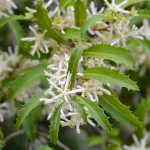 Sold Out
Sold Out
Hoheria angustifolia, Houhere, commonly known as Narrow-leaved Lacebark, is a tree native to New Zealand. It is a member of the family Malvaceae and is known for its striking appearance, with its slender leaves and attractive flowers. The leaves of Hoheria angustifolia are narrow and lanceolate.
The flowers of Hoheria angustifolia are one of its most distinctive features. They are typically large and showy, measuring 1.5-2 cm in diameter and arranged in clusters at the tips of the branches. The flowers are usually white and fragrant, and attract pollinators such as bees and butterflies.
The bark of Hoheria angustifolia is smooth and greyish-brown when young, becoming rougher and more fissured with age. The bark peels off in strips, revealing a lighter colored inner bark, which adds to its aesthetic appeal.
Hoheria angustifolia is primarily grown as an ornamental tree in gardens and parks, appreciated for its graceful form, attractive flowers, and interesting bark. It is also used in ecological restoration projects for its ability to attract pollinators and provide habitat for birds and insects.
History of use: The inner bark of Hoheria angustifolia has been used traditionally by Maori for making rope and twine.
Habitat: A common mostly lowland forest species frequenting alluvial forest where it may at times be dominant. Hoheria angustifolia is often an important host for taapia (Tupeia antarctica).
Flowering: Summer [December - March]
Fruiting: [February - April]
My Lists: Low Flammability Plants, Rongoa
Myrsine australis (Mapau, Red Matipo)
 Sold Out
Sold Out
Myrsine australis, or Red Matipo, forms a handsome large shrub or tree with distinctive red branchlets and wavy leaf margins. Similar in appearance to Pittosporum tenuifolium. The cream flowers and later the black fruit are in clusters below the leaves. Used as a specimen, shrub border or hedge.
Habitat: Occurs in lowland forests. Common tree of regenerating and mature forest in coastal to montane situations.
Flowering: Spring - Summer [September - February]
Fruiting: Autumn [March - October]
My Lists: Low Flammability Plants, Rongoa
Pittosporum eugenioides (Tarata, Lemonwood)
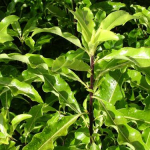 Sold Out
Sold Out
Pittosporum eugenioides, Tarata, commonly called Lemonwood, is a bushy tree ideal as a specimen or for hedging. Lemon scented foliage and fragrant flowers (spring).
Great in a windy position and also provides a barrier for the surrounding more intolerant plants. Pittosporums can be excellent stand-alone features, hedges, screens, windbreaks, shrubberies or topiary specimens. The highly ornamental, evergreen foliage almost always looks well-groomed and responds well to pruning. Frost tender when very young. Prefers a sunny to part shade position, does not mind the wind, and thrives in soil with good drainage. Tarata is somewhat drought-resistant therefore rainfall is not a major factor in its survival.
It has proved to be a great plant for establishing a quick canopy in a restoration project. It then provides an opportunity to introduce understory, shade loving plants to the same location, later planting underneath the lemonwood trees. Lemonwood is on the recommended list for replanting “small trees up to 6m.”
History of use: Maori used the gum from the bark in complex scent formula along with parts of other plants.
Habitat: Common tree of regenerating and mature forest in coastal to montane situations. It is found in forest clearings and along forest margins up to 600m above sea level.
Flowering: Spring [October - December]
Fruiting: Autumn [March - May]
My Lists: Erosion Control, Low Flammability Plants, Rongoa
Plagianthus regius (Manatu, Lowland Ribbonwood)

Plagianthus regius, Manatu, or Lowland Ribbonwood is a deciduous tree grown for its foliage and flowers. A profusion of small white or green flowers appears in large panicles in spring making it easier to distinguish from the similar lacebark.
Like many New Zealand native Plagianthus regius has a juvenile form that becomes a straight trunked medium to large tree. The juvenile form has bushy interlacing branches with small leaves, while an older tree will tend to have larger leaves, sometimes with the lower parts of the tree still displaying divaricating leaves.
Habitat: Coastal to lower montane. Often a prominent tree in lowland alluvial forest.
Flowering: Spring [September - November]
Fruiting: [December - January]
My Lists: Erosion Control, Low Flammability Plants
Pseudopanax arboreus (Whauwhaupaku, Fivefinger)
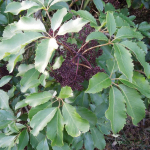 Sold Out
Sold Out
Pseudopanax arboreus, commonly called Fivefinger, is one of New Zealand's most common native trees found from Cape Reinga to Bluff in lowland forests. Its particular form of a glossy, five to seven fingered leaf along with quick and luxuriant growth. It grows into a small stout tree up to 5 metres high and grows well in most soils and situations. Fast growing with small purplish black berries in autumn.
History of use: New Zealand Beekeepers Magazine rates Pseudopanax arboreus as a star performer for food for bees. The trees provide abundant pollen and copious, rich nectar very early in the season when few other species are in flower (from June to August). Plant in good numbers clustered together to amplify the availability of flowers for bee feed. Bees love the small scented green flowers that are followed by bunches of dark purple fruits enjoyed by birds from August to February. Flower buds can be easily mistaken for ripe fruit whereas clusters of fruit are actually ripe one year after flowering.
Habitat: Coastal to montane. Moist broadleaf forest. Frequently epiphytic. A frequent component of secondary forest and forest margins. Tolerant of moderate frosts and coastal conditions but should be sheltered from strong winds.
Flowering: Winter [June - August]
Fruiting: Spring - Summer [August - February]
My Lists: Low Flammability Plants, Rongoa, Winter Pollen
Pseudopanax crassifolius (Horoeka, Lancewood)
 Sold Out
Sold Out
Pseudopanax crassifolius, commonly known as Lancewood or Horoeka, is a species of evergreen tree that is native to New Zealand. It belongs to the family Araliaceae and is known for its unique growth habit and distinctive foliage.
Lancewood typically grows to a height of 3 to 10 meters, though it can reach up to 15 meters in favorable conditions. It has a slender, erect trunk that is often unbranched for several meters, giving it a distinctive lance-like appearance. The trunk is smooth and grayish-brown in color, and it is often marked with vertical ridges or scars from fallen leaves.
The leaves of Pseudopanax crassifolius are leathery and glossy, with a lanceolate shape that tapers to a point. They are typically dark green in color and can measure up to 60 centimeters in length. The margins of the leaves are serrated or toothed, which adds to their distinctive appearance.
One of the most striking features of Pseudopanax crassifolius is its ability to change its leaf shape as it matures. Young Lancewood trees have long, narrow leaves with serrated margins, while older trees develop larger, broader leaves with smooth margins. This unique leaf morphology has earned it the nickname "lancewood" due to its resemblance to a lance or spear.
Pseudopanax crassifolius produces small, inconspicuous flowers that are typically green or cream-colored. The flowers are arranged in clusters and are followed by small, fleshy fruit that ripens to a dark purple or black color. The fruit is an important food source for native birds in New Zealand.
Lancewood is a hardy plant that is well-adapted to New Zealand's coastal and lowland forests. It can tolerate a wide range of soil types, but prefers well-drained soils. It is a slow-growing species and can take many years to reach maturity.
In addition to its unique appearance, Pseudopanax crassifolius has cultural significance for the Māori people of New Zealand, who have traditionally used its wood for various purposes, including weapons, tools, and construction. Today, it is also a popular ornamental plant in gardens and landscapes, prized for its distinctive foliage and architectural form.
Habitat: Lowland to montane forest. Sealevel to 750 m
Flowering: Summer - Autumn [January - April]
Fruiting: Autumn [January - April]
My Lists: Low Flammability Plants, Rongoa
Sophora microphylla (South Island Kowhai)
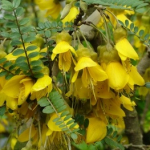
Sophora microphylla is also known as South Island Kōwhai, having showy yellow flowers in early spring. This particular Kōwhai has very small leaves (microphylla) and a tangled juvenile form, tending to straighten up and grow from an upright trunk at about four years. Kōwhai makes a good garden tree and is necessary for revegetation projects as a bird attractor. Kōwhai are suited to upper bank plantings of riparian areas. They also make beautiful shade or specimen trees. Semi-deciduous. Hardy.
Sophora microphylla have horn-shaped yellow flowers. The nectar is a favourite food for Tui, Bellbird and Kererū which also eat the leaves. The seed pods which appear after flowering stay hanging on the tree through winter.
Kōwhai is the national flower of New Zealand.
Habitat: In the North Island, especially the northern half this is a species of mainly riparian forest. South of Hamilton it can be found in a diverse range of habitats from coastal cliff faces and associated wetlands to inland grey scrub communities. Sophora microphylla and Sophora prostrata are the only forms naturally existing in Canterbury.
Flowering: Winter [August - October]
Fruiting: Spring - Summer [October - May]
My Lists: Low Flammability Plants, Rongoa, Winter Pollen
Sophora prostrata (Dwarf Kowhai)
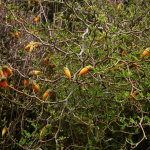
Sophora prostrata, commonly known as Dwarf Kowhai, is a low-growing shrub or small tree species that belongs to the family Fabaceae. It is native to New Zealand and is known for its vibrant yellow flowers and unique, prostrate growth habit.
One of the most distinctive features of Sophora prostrata is its striking yellow flowers, which are pea-like in shape and arranged in clusters at the ends of the branches. The flowers usually appear in late winter or early spring, and their bright yellow color is a standout feature against the dark green foliage. The flowers are attractive to bees and other pollinators.
Sophora prostrata is endemic to New Zealand, where it is found in a variety of habitats including coastal cliffs, sand dunes, shrublands, and forests. It is particularly well-adapted to tolerate salt spray and harsh coastal conditions, which makes it suitable for coastal gardens and landscaping.
Sophora prostrata serves as an important host plant for the caterpillars of several native butterfly species. Additionally, Sophora prostrata is a popular ornamental plant in gardens and landscapes due to its attractive flowers and unique growth habit. Semi-deciduous. Very tough on exposed, cold, dry sites.
Habitat: Found from the coast to subalpine in open rocky planes. Confined to the eastern South Island from Marlborough to the Waitaki Valley.
Flowering: Spring [September - October]
Fruiting: Summer [January - February]
My Lists: Low Flammability Plants
Veronica salicifolia (Koromiko, Hebe salicifolia)
 Sold Out
Sold Out
Veronica salicifolia, Koromiko, formerly called Hebe salicifolia, is a fast-growing large, spreading shrub. Provides good low shelter and is an excellent revegetation plant. It has showy white to pale lilac drooping flowers and willow-like foliage. Prefers a moist soil. Trim after flowering in a garden setting.
Veronica salicifolia is a hardy plant but isn’t tolerant of shade and needs to be grown in full sun and in a sheltered area with well-drained soil. It can, however, tolerate wet areas and can often be found on the edge of bush and wetlands. Once established they have considerable drought and frost tolerance.
History of use: The Māori utilized the plant’s medicinal properties for centuries. The leaves were chewed to help cure diarrhoea and applied to the skin to aid ulcers and wounds. Koromiko is the general name for the Hebes in Te Reo and is shared over a range of New Zealand Veronica species.
Habitat: Occurs from sea-level to close to the treeline, mostly in open sites, and forest margins. Is used in lower bank riparian edges where their roots can dry between rain events, but the soil stays damp.
Flowering: Summer [December to May]
Fruiting:
My Lists: Low Flammability Plants, Rongoa
Veronica salicifolia Snowdrift (Hebe salicifolia Snowdrift)

Veronica salicifolia Snowdrift, formerly know Hebe salicifolia Snowdrift, has white flowers appear through the summer. A larger growing shrub that looks good throughout the year. The olive green leaves are long and narrow. Trim after flowering to promote new growth.
Flowering: Summer [December to February]
Fruiting:
My Lists: Low Flammability Plants
